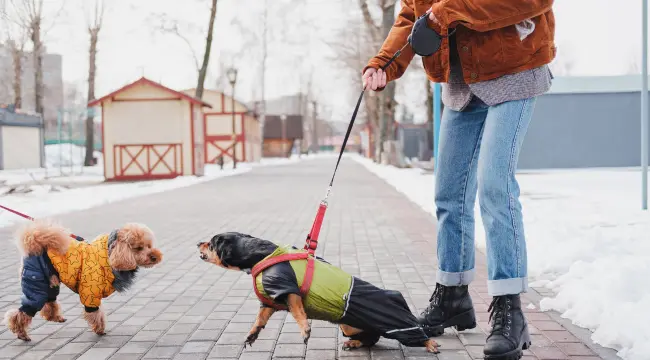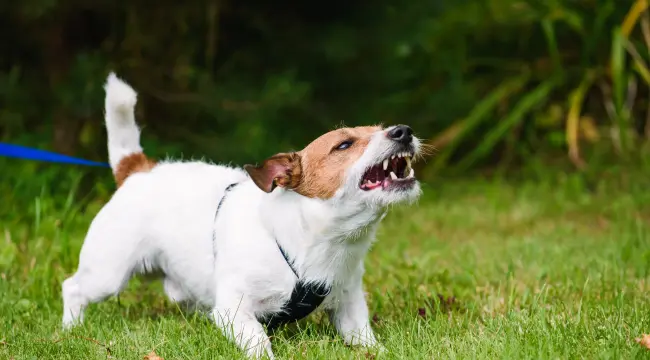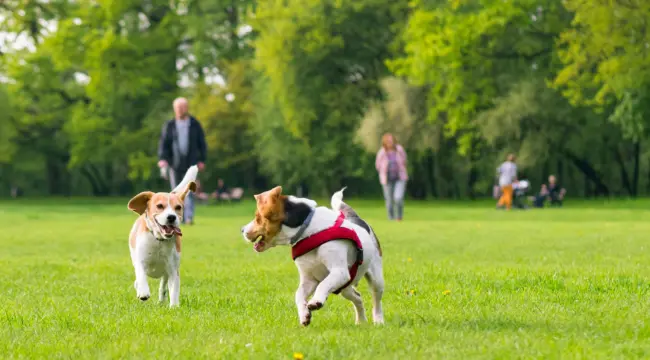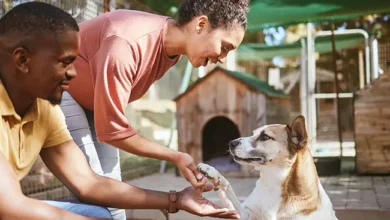10 Tips To Train Your Dog To Get Along With Other Dogs

Training your dog to be friendly with other dogs is essential for several reasons. For one thing, having friends and playmates is good for their health and well-being. Moreover, dogs that are well-socialized and can get along with their furry friends are generally more confident, less aggressive, and better behaved overall than those who are not exposed to other dogs early on in life.
Allowing your pet to socialize also helps them develop appropriate behaviors around other people. On the other hand, dogs that lack proper socialization may be uncomfortable around people, overreact when approached by someone new, or when you must leave them to dog care services like dog boarding Toronto, and this can lead them into trouble if they’re not appropriately trained.
However, getting your dog to play nicely with others isn’t always easy. This article has outlined some tips and tricks to help you train your dog to get along with other dogs. Whether you’re starting with a new puppy or working with an older dog, these tips can help you create a safe and positive environment for your furry friend when socializing with and making new friends.
Methods to Control a Dog’s Aggression

If your once loyal, cuddly, and cute dog has suddenly started showing aggression, there could be various reasons for this unexpected behavior change. Interestingly, certain illnesses can make dogs become aggressive. If your dog has never shown aggression before but now growls, snaps, or bites, it might be due to a disease or illness. Another possibility is that your dog is in pain from an injury. Sometimes, a dog can sense or smell something on a stranger that triggers their aggressive behavior. In the following discussion, we will explore methods to help you control your dog’s aggression effectively.
1. Train Your Dog With Basic Commands
It’s essential to ensure that your dog understands basic commands like “heel,” “sit,” and “down.” Teaching them additional commands like “stay” or “lie down” and training them to hold these positions for longer periods of time will help develop their self-control, making your daily walks much easier.
When your aggressive dog responds to your commands, your walks will become more enjoyable. By being proactive and anticipating potential problems, you can avoid aggressive situations before they escalate. For example, if you see another dog approaching, instruct your dog to lie down and calmly communicate with them until the other dog passes by.
However, it’s important to note that if a dog approaches and starts a fight, your dog may lose trust in you and become hesitant to follow the “down” command. While basic obedience is important, it may not be the sole solution to your specific problem.
2. Opt for a Short Leash and Consider a Muzzle
While slip collars, also known as choke chains, have fallen out of favor in many dog training circles, they can still be useful in certain cases. Although they may not address the underlying behavior issue, they can temporarily stop the undesired behavior. However, it’s important to note that this change often occurs only when the dog is wearing the leash.
To prioritize your dog’s comfort, I prefer crafting slip collars from soft cotton rope. These alternatives lack the abrupt tightening effect of traditional choke chains and are more gentle on the dog’s throat. Additionally, I highly recommend considering a basket-type muzzle made of wire or silicone. This kind of muzzle allows the dog to open their mouth and pant while walking, and it applies gentle pressure on the dog’s nose, which can have a calming effect in some cases. It’s worth noting that not all dogs require muzzles, but I’ve found this type to be the most effective. It can help prevent biting incidents, protect your dog from being labeled as dangerous, and potentially save them from being euthanized by animal control.
3. Implementing Avoidance
While avoidance alone may not provide a definitive solution to aggression, it can significantly alleviate many of the challenges you encounter. When you cross paths with another dog during your walk, simply redirect your dog’s attention and guide them away from the situation, creating a safe distance where they no longer feel threatened. In instances where walking away isn’t possible, position yourself in front of your dog, strategically blocking their view to prevent them from fixating on the other dog.
By combining obedience training, utilizing a slip collar and muzzle, along with the practice of avoidance, you can enhance the effectiveness of your efforts. If these techniques fail to bring you a sense of tranquility during your dog walks, don’t hesitate to explore these alternative methods and incorporate them into your training repertoire.
4. Flooding: A Technique to Consider
Flooding is a training method that involves facing your dog’s fears directly. In this case, it means helping your dog get used to being around other dogs, realizing that nothing bad will happen, and becoming less sensitive to their presence.
It’s important to know that flooding can be stressful for your dog and isn’t recommended if there are other methods you can try.
If you want to introduce your dog-aggressive dog to another dog, make sure the other dog won’t attack or try to be the boss. Find a neutral area for them to meet, and be sure to use a muzzle on your aggressive dog in case they manage to get loose.
5. Classical Conditioning
When your dog acts aggressively in certain situations, like when approached by another dog on a leash, classical conditioning can be a helpful approach. Here’s how it works: as soon as your dog starts displaying negative behavior, give them special treats that they don’t usually get during regular training sessions. This helps your dog associate the presence of other dogs with positive things. You can also try speaking to your dog in a calm voice while giving them treats to help them feel more relaxed.
It’s important to know that trainers who use this method suggest avoiding slip collars. Classical conditioning takes longer than flooding because your dog is exposed to strange dogs for only short periods of time until they become familiar with them. However, the results tend to last longer.
In some places, there are classes available where you can work with other dog owners who are dealing with the same problem. If you don’t have access to such classes, you can try practicing with a friend’s help. Make sure you have control over your dog, and while you give treats, have your friend walk by with their dog. Repeat this practice every day or as often as possible. Over time, your dog will start to associate the sight of another dog with something positive.
It’s important to note that some dogs may still have issues if they encounter a loose dog, a group of dogs, or a dog in heat. If you can find a dog training group that specializes in this technique, you’re likely to achieve better results.
6. Take Your Dog To A Dog Daycare
Dog daycares and other safe and contained pet daycares are a great way to help your dog socialize and learn to interact appropriately with other dogs. In a dog daycare setting, your dog will have the opportunity to play and interact with other dogs under the supervision of trained professionals who can help ensure that all interactions are safe and positive.
When choosing a dog daycare, it’s essential to look for one with experienced staff trained in dog behavior that can provide a safe environment for your furry pal. You should also find a daycare that requires all dogs to be up to date on their vaccinations and has clear policies for dealing with aggressive or inappropriate behavior.
Once you’ve found a dog daycare that meets your criteria, introduce your dog to the facility slowly and carefully. Start by taking them for short visits and gradually increasing the time they spend there as they become more comfortable. It’s also good to watch your dog’s behavior closely during these visits to ensure they enjoy themselves and interact positively with other dogs.
7. Use Positive Reinforcement
Positive reinforcement can be a powerful tool when training your dog to socialize. By rewarding them for good behavior during interactions with other dogs, you can help to reinforce positive habits and discourage negative ones. For example, if your dog is playing nicely with another dog, you can reward them with treats or praise to reinforce that behavior. In contrast, if your dog shows signs of aggression or fear, you can redirect their attention and reward them for remaining calm and relaxed.
Using positive reinforcement when training your dog to socialize can also help create a positive association with other dogs. When you reward them for good behavior during interactions with other dogs, you can help them feel more comfortable and confident around their furry friends, which can lead to more positive interactions and help prevent behavior problems such as aggression or fear.
8. Start Slowly
If your dog isn’t used to being around other dogs, it can help to start slow. Starting slowly can help your dog feel more comfortable and less overwhelmed during socialization experiences. It can also help prevent negative interactions and build positive associations with other dogs.
So, begin by introducing your furry pal to one or two friendly dogs in a controlled environment. This can be a backyard or a quiet park. Keep the interactions short, around 10-15 minutes, and observe your dog’s body language to ensure they are comfortable. Remember also to keep them on a leash during the initial interactions so you can easily control the situation in case of any negative interactions. If necessary, use barriers such as baby gates or playpens to separate the dogs.
As your dog becomes more comfortable with other canines, gradually increase their time together. This can be done by extending playtime or going for long walks together. With patience and consistency, your dog can become a confident and well-adjusted member of the canine community.
9. Use Neutral Territory

When introducing your dog to a new dog, using a neutral territory such as a park, playground, or any new area is recommended. Neutral territory means a place where neither dog has been or where neither dog resides. This approach can prevent territory issues and make getting along easier for the dogs.
10. Spay or Neuter Your Dogs
Dog aggression can be influenced by reproductive hormones, making intact dogs more prone to aggressive behavior. However, by spaying or neutering your dogs, you can help reduce the likelihood of aggression and foster better socialization with other dogs.
Spaying is the surgical removal of a female dog’s reproductive organs, while neutering refers to the surgical removal of a male dog’s testicles. These procedures not only prevent unwanted pregnancies but also have behavioral benefits. Spaying or neutering can help regulate hormone levels, reducing territorial instincts and aggression in dogs.
When introducing your dog to potential playmates, it’s important to consider whether those dogs have also been spayed or neutered. Dogs who have undergone the same procedure are likely to exhibit less dominance-related aggression, making it easier for them to get along and enjoy social interactions.
Spaying and neutering are common procedures performed by veterinarians, and they offer numerous health and behavioral advantages for dogs. It’s recommended to consult with your veterinarian to determine the most appropriate timing for spaying or neutering your dog based on their breed, age, and overall health.
By taking the step to spay or neuter your dogs and ensuring other playmates have undergone the same procedure, you can contribute to a more peaceful and enjoyable experience for everyone involved, while also promoting responsible pet ownership.
Wrap Up
Training your dog to mingle with other dogs takes time and patience. However, don’t get discouraged if progress is slow; instead, celebrate small victories along the way. With these tips, you can help your dog learn appropriate social behavior and can become a well-socialized and happy member of the canine community.


